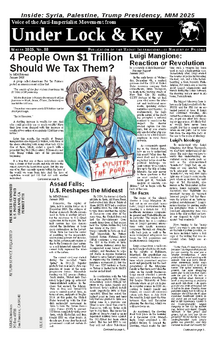
Understanding Solitary Confinement
UPDATE: On 9/17/2009 the comrade who wrote this letter was killed in Attica Correctional Facility
True solitary confinement - it’s general concept, ultimate purpose, and all of its myriad applications - must be exposed to as many concerned citizens as is possible. Media, cinema, and corrections spokespeople have all contributed to distorting our society’s perception of this shameful and torturous practice that has been a facet of this country’s history since it’s earliest years.
Amnesty International has defined solitary confinement as “all forms of incarceration that totally remove a prisoner from inmate society”, elucidating further that “the prisoner is visually and acoustically isolated from all other prisoners as well as having no personal contact with them.” But even this definition can forfeit the consideration of other variations of confinement that similarly and adversely affect the prisoners who are imprisoned in them. Professors Craig Haney and Mona Lynch concluded and supported with irrefutable evidence from the study they conducted that solitary confinement refers to a broad set of conditions, including single-celled control units where even some semblance of communication between prisoners is somehow feasible, double-celled control units that produce conditions of both isolation and overcrowding simultaneously, control units where prisoners are subjected to sensory overload as well as sensory deprivation, and control units that impose “small group isolation.” The effects of solitary confinement in all of its manifestations within this country’s prison system have been recognized by numerous authoritative analysts, as well as their impact upon society as a whole. Studies of this phenomenon, empirical and with scientific experimentation, have been conducted and recorded as early as 1790.
With this in mind, terms such as “punitive segregation”, “restrictive housing”, “segregated housing”, “special housing”, “administrative segregation”, “disciplinary confinement” and “control units” have all been used to designate constructed environments that employ what are essentially conditions- whether in part or whole - of solitary confinement. Despite their differences, all of them serve similar ends in that all of them employ torturous conditions as punishment rather than rehabilitation.
I have been a prisoner of the New York State Department of Correctional Services prison system for approximately fifteen years to date. I have spent at least two-thirds of those years confined to the system’s special housing units (SHU) for lengthy and continuous periods at a time. Recently, former New York State Governor Eliott Spitzer signed a bill into law that provides for mentally ill prisoners who have been sanctioned with disciplinary confinement penalties exceeding thirty days to be removed from conventional SHU’s and placed in newly constructed “therapeutic units.” The majority of these “therapeutic units” are actually conventional SHU’s amended with rooms designated for therapeutic group programming and individual therapy sessions. The rooms are fitted with “cubicles” that amount to small single-occupancy cages, to restrict prisoners contact with program instructors and each other during “therapy.” Whether this arrangement is a genuine and sufficient departure form conventional SHU to ward off mental deterioration fostered by the conditions of the various forms of solitary confinement seems to have escaped adequate forum for public debate.
One of the worst SHU’s I have been confined to, by my estimation, is the notorious F-Block at Great Meadow Correctional Facility in Comstock, New York. I remained there for just over a year.
In their State of the Prisons report on conditions of confinement in 25 New York correctional facilities, published in 2002, the Prison Visiting Committee of the Correctional Association of New York described the SHU at Great Meadow CF as “… one of the most unsettling we have experienced. Many of the inmates were mentally ill and confined in cells behind thick metal doors or bars covered with Plexiglas to protect staff from”throwers.” Most striking was the pervading sense of chaos and the way in which inmates with mental illness are isolated, cut off from human contact and caged in barren, concrete walls. Animals in zoos are kept in more humane conditions… the more stable inmates spoke of the constant yelling and noise on the unit, the stench of feces and sweat, and the lack of ventilation.” Although the SHU capacity had been reduced since the time of that report, the conditions aforementioned were certainly prevalent even during my confinement there in 2004 and 2005.
With the draconian measures put in place by the Bush administration as a device of its purported “war on terror,” and a look to the conditions under which prisoners designated as enemy combatants are being held in at the detention complex in Guantanamo Bay by the U.S. government, I do not see that the use of solitary confinement is being diminished at all. Rather, I foresee that it will expand and morph into forms less conspicuous but more insidious, cultivated with and nurtured by the incitement of mass hysteria and the greed of profiteers.
After clarifying the general concept, myriad applications and ultimate purpose of solitary confinement, this information must be conveyed to the concerned active citizenry. The concept, applications and purpose of solitary confinement serve to control and inflict suffering upon a segment of the population through isolation and deprivation. It does not nor has it ever served to rehabilitate or improve the condition of society.
sources: “Regulating Prisons of the Future”, by Craig Haney &
Mona Lynch, 23 NYU Rev. L. Soc. Change 447 (1997).
“State of the
Prisons” Report, June 2002, by the Correctional Association of New
York.
“Enemy Combatant” by Moazzam Begg (the New Press, 2006).








